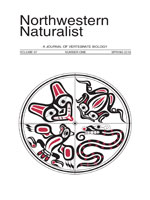In July 2014, we conducted nest counts at 7 of 8 known breeding colonies of Pelagic Cormorants (Phalacrocorax pelagicus) in western Queen Charlotte Strait, British Columbia, to assess the current status of this population. Four nests were found on Dugout Rocks, the only known colony still used; 1 nest was found at Pine Island, a 9th (newly recorded) breeding location in the region. Total numbers of nests in this region declined 97% from 197 to 231 nests in 1975–1976, to 60 nests in 1982–1988, to 5 nests in 2014. Limited evidence suggests that Bald Eagle (Haliaeetus leucocephalus) disturbance and predation may be the main reason for this major decline in the cormorant breeding population. Historical population size of Pelagic Cormorants prior to the 1960s also may have been quite low, with breeding 1st recorded in this region in 1968, although little prior survey effort occurred. Population growth probably occurred in the 1960s and early 1970s to reach the population size noted during the 1st complete survey in 1975–1976, during a period of reduced impacts from eagles.
How to translate text using browser tools
12 April 2016
Decline of the Pelagic Cormorant in Western Queen Charlotte Strait, British Columbia, 1975–2014
Harry R Carter
ACCESS THE FULL ARTICLE

Northwestern Naturalist
Vol. 97 • No. 1
Spring 2016
Vol. 97 • No. 1
Spring 2016
British Columbia
colony
nest
Pelagic Cormorant
Phalacrocorax pelagicus
roost
survey




